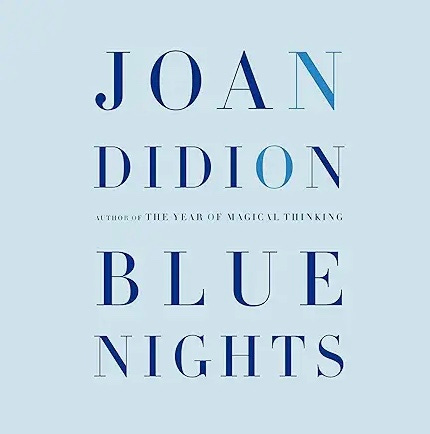BookLife Dual Review by Carol O’Day: The Year of Magical Thinking and Blue Nights (Joan Didion, author)
Memoir, grief, sudden death, death of spouse, death of daughter, aging, reflection, memory, National Book Award winner, Pulitzer prize finalist
When Joan Didion died in 2021, I had several of her books to my to-read list but I had not managed to read them. What an oversight that was. I now plan to read more of her work. Her award-winning masterpiece, The Year of Magical Thinking (National Book Award Winner, 2005 and Pulitzer Prize finalist), was my starting point. It was so thoughtful, moving and insightful, that I continued and read its companion of sorts, Blue Nights.
In December of 2003, on a somewhat ordinary evening, Joan’s husband, John Dunne, was enjoying a pre-dinner cocktail and Joan was assembling dinner when, in an instant, her world turned on its axis and everything changed. John suffered a massive cardiac event and died before the first responders arrived. Theirs was an exceptionally close marriage and relationship; they both worked from home, travelled to film locations together, and were rarely apart for over forty years. The couple had one daughter, Quintana, whom they had adopted in 1966, and Quintana is why the evening of John’s death had not been ordinary. Quintana lay unconscious in an ICU bed in a New York hospital blocks from their New York apartment suffering from sepsis. Joan and John had just returned from visiting her before he died.
In an almost unspeakable compounding of tragedy, Didion’s daughter Quintana died not quite two years after her father’s death. Quintana was 39 years old when she died and had been married for two short years. Joan had barely emerged from the fog of John’s sudden death when she lost Quintana. Following Quintana’s death, Joan wrote Blue Nights. Though this second experience of grief, Quintana’s death, was the catalyst for Blue Nights, the book is only in part about Quintana’s life and death. It is perhaps more a reflection on complicated grief and on aging, loneliness and mortality.
The book’s title refers to the particular phenomenon that occurs, as Didon states in the book’s opening lines,
In certain latitudes there comes a span of time approaching and following the summer solstice some weeks in all, when the twilights turn long and blue. This period of blue light does not occur in subtropical California . . .but it does occur in New York where I now live. You notice it first as April ends and May begins, a change in the season, not exactly a warming–in fact not at all a warming–yet suddenly summer seems near, a possibility, even a promise….[The] actual light is blue, and over the course of an hour or so this blue deepens, becomes more intense even as it darkens and fades . . . .
These blue nights are at once the harbinger of death and the experience of grief.
Didion’s writing is sublime. It is elevated by the depth of her knowledge of literature, her habit of keeping journals and mementos that preserve the details of important moments and events, and her gift for language. She has a unique ability to appear to allow her thoughts to wander across the page or a chapter in what feels like a natural meandering of her reflections, interspersed with snippets of conversations remembered, or dreams recounted. The reader enters this flow as if these associations are the reader’s own though associations. These passages are anything but meandering or random. They are a literary fugue; recurring phrases of melodious words that repeat and recur and unwind. Didion recalls a passage or a comment made by her husband or her daughter, or she reads a poem or literary passage in which a particular line resonates. She grabs hold of that line or comment and locks it onto a page in italics, often in double-spaced line format. Didion then expounds on its meaning or the memories it triggers as she puzzles out its significance of the past moment or present thought. She gently chews on it throughout a chapter, and sometimes again later in the book.
Didion circles back to these lines and revisits them. Piece by piece, word by word, remembered phrase by remembered phrase, she constructs her growing understanding of their meaning in her life. She disassembles her grief and builds it into her recovery, her forward living. She ponders her daughter’s childhood dreams of The Broken Man, and wonders what that dream meant to Quintana, and why the dream stopped. She recalls a story her daughter wrote as a child, perhaps modeling her writer parents, and struggles with the dark sentiment her daughter logged at the story’s conclusion—Quintana’s belief that her parents cared little for her. She revisits Quintana’s experience of being discovered by her biological family and the ways in which she, her husband and Quintana responded to it. She wonders if she missed significant moments in her daughter’s emotional life, moments and conversations unspoken and answers now unavailable to her after Quintana’s death. She circles the beast that is her own aging, and her own mortality, grappling with symptoms and concluding that mortality is about one’s children, more so that about one’s own decline.
My wish for readers of BookLife: Reviews for Readers is that they gift themselves these two works by Joan Didion to read when the days are long and demands of time and schedule are reduced. Perhaps the pace of a summer will allow readers the pleasure of reflection, and the ability to take from Didion’s sparkling words, the tidbits and truths that will inform their own grieving when it visits them, or their own encounters with the throes of aging and our own inescapable mortality.
Support BookLife: Reviews for Readers and independent bookstores by purchasing The Year of Magical Thinking and Blue Nights via Bookshop.org using the links below:
Purchase The Year of Magical Thinking here, or in paperback here.
Purchase Blue Nights in paperback here.






